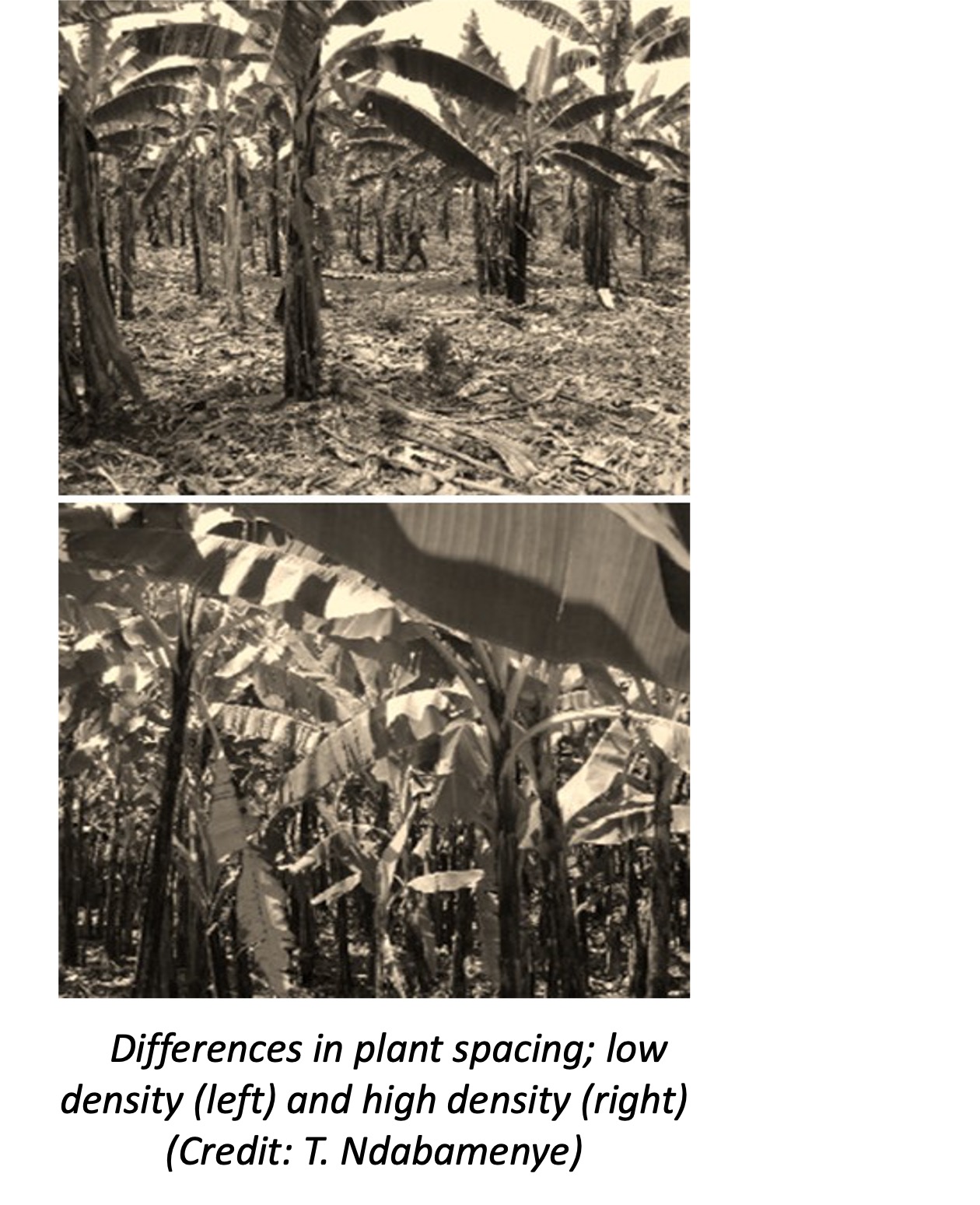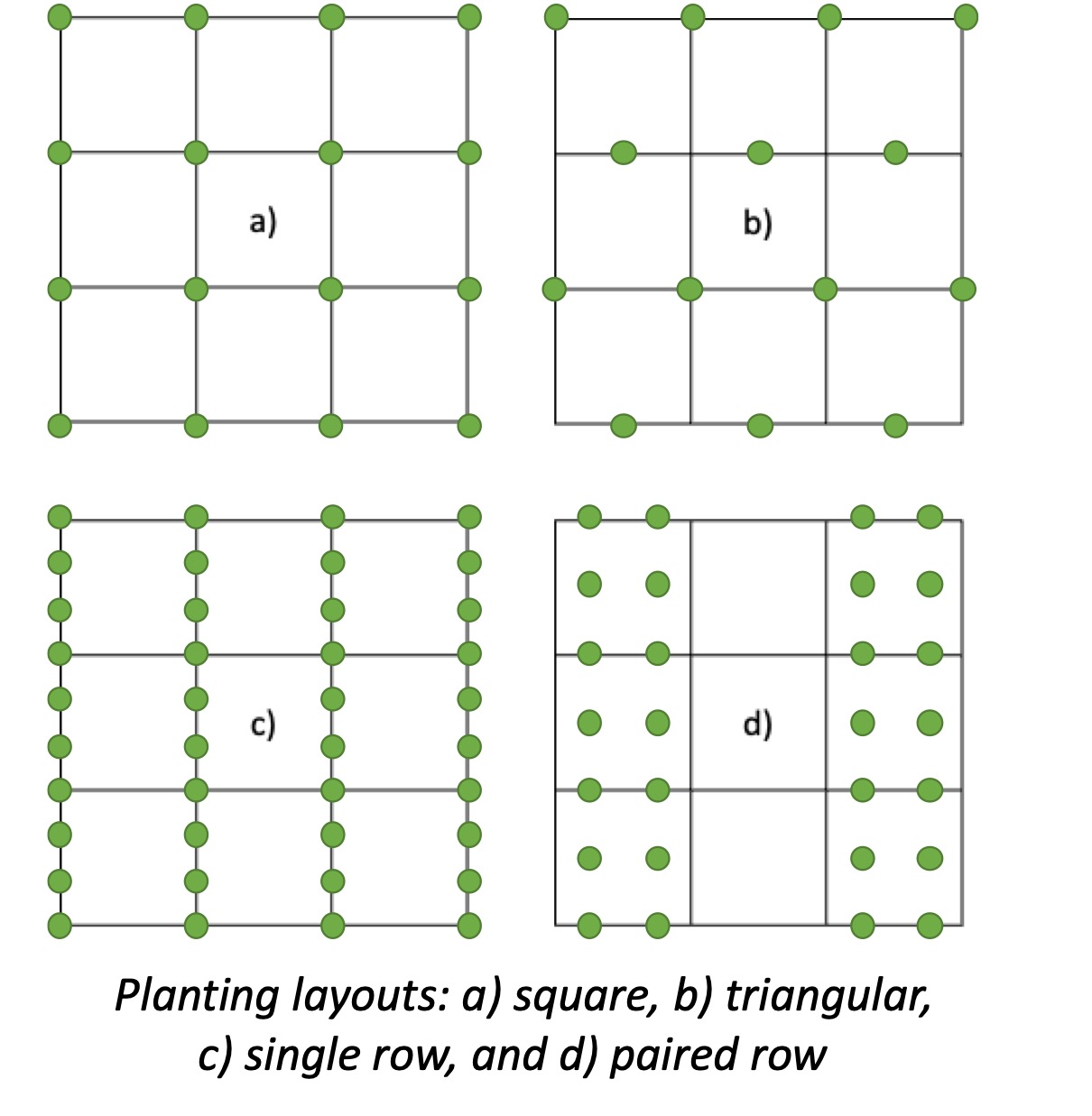Spacing and Stand Management in Banana and Plantain
Summary
Spacing of banana and plantain is based upon the stature of the variety and expectations of the farmer. Most varieties are spaced 3 m x 3 m apart, or 1,111 plants per ha. Dwarf varieties are planted at densities of 2 m x 2 m (2,500 plants per ha) or less. Very large varieties are planted at 4 m x 4 m. Note that the fibrous roots of even dwarf varieties can extend for 6 m. Spacing can also depend upon soil fertility level, and rainfall. Bananas are best planted in square blocks because the plant is adversely affected by wind. When planted in blocks, the plants provide protection to one another. Another consideration is the practice of establishing young plants in excavated holes of at least 30 cm x 30 cm x 30 cm that is fortified with organic materials. Establishing a large number of new plants thus requires considerable compost or manure, particularly if the soil is less fertile. Banana and plantain require abundant moisture with good drainage. Rows should be straight in flat fields to give plants the maximum amount of sunlight. On slopes, rows should follow the contour lines to decrease soil erosion.
About the Solution
Careful attention must be paid to planting arrangement and density when establishing banana and plantain as stand management affects labor requirements as well as bunch size and yields. Higher densities lead to excess competition for light, nutrients and water and result in taller, weaker stands with delayed maturity. Lower densities may lead to excess weed competition but provide scope intercropping. Another consideration is the need to rotate plantation areas over time due to the accumulation of a host of pests and diseases, with a typical stand area of 8 to 10 years before rotation is needed. Dwarf Cavendish, a widespread dessert variety, is planted at densities of 2500 to 4400 plants per ha and can provide as much as 100 t/ha/year qith smaller bunches and fruits produced at higher planting densities. Plants arranged within blocks result in stands with desirable humidity and temperature levels. Most cooking bananas and plantains are larger and must be planted at wider spacing such as 3 m x 3 m forming 1,111 mats per ha. Some banana and plantain varieties are particularly large statured, growing to heights of 8 m and producing large mats with many shoots. These varieties should be planted at spacing of 4 m x 4 m or more. It is important to note that spacing greatly influences the expression of weeds, and that with proper spacing and residue management it is possible to establish plantation understories that are virtually weed free.
The optimal density is a function of cultivar type, climatic conditions that influence water availability, soil fertility levels, and interactions among these factors. Farmers must learn which varieties perform best for them and what spacing they require. For example, research in Rwanda found that under lower rainfall (<1,000 mm), yields attained a maximum at 3,333 plants ha−1 for cooking cultivars “Injagi” and at 4,444 plants ha−1 for “Ingaju”. Under higher rainfall (>1,000 mm), the yields of these cooking cultivars increase beyond stand densities 5,000 plants ha-1.
Different types of planting systems exist that align with specific farm conditions and production objectives. Small-scale farmers mostly adopt the square system where plants are positioned at each corner with a spacing of 2 x 2 m or 3 x 3 m. In a triangular system, the plants in alternate rows are positioned in the middle of the square instead of the corner. In a single row system, plants are closely spaced within the line (0.5 - 0.8 m), whereas the distance between the row is wide (1.8 - 2 m). In a paired or double row system, two lines of bananas are planted at 0.9 to 1.2 m with plants located at equal level, and paired rows are spaced at 2 to 2.5 m. On fields with very steep slopes a contour system is best used where plants are grown in lines of equal height using pits and plants in alternating lines should be staggered to minimize soil erosion. During early establishment the use of herbicides may be required to control weeds, with systemic contact herbicides such as glyphosate performing best.
Plant density is often expressed as the number of mats per hectare, with a mat consisting of a mother plant and its suckers of younger generations. To determine the average spacing between mats, the distance of the mother plant in one mat and that of four closest mats is measured. “Earthing-up” of the stem base and additional support of mature bunches is required in areas prone to strong winds. Herbicide must be applied before the weeds start producing seeds and should not be sprayed on the banana plants themselves, intercrop, or naked soil. Contact herbicides can be used at the beginning of a production cycle and may need to be reapplied for controlling perennial grass. Systemic herbicides are recommended for established plantations. Operators can target which plants to remove and which to maintain favoring the establishment of a natural plant cover. Mechanical weeding is possible in double row plantations with larger alleys that allow rotavators to pass without damaging stems. Under such management it is important to use lighter attachments to avoid soil compaction. Using optimal plant density, increased water use efficiency and can reduce irrigation requirements by 30-40%, and result in 25% higher nutrient uptake from fertilizers. High density planting makes stands less vulnerable to damage from wind but can result in accelerated pest and disease accumulation.
Commercialization
Commercially available
Solution Images
Institutions



